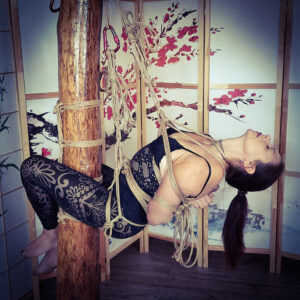Seilung Blog-Seite
Bondage, Shibari, Kinbaku, ties?
From Shibari to Kinbaku: The Power of Words

Disclaimer: Personal Reflections on the Meaning of Words
Before delving into the complex terms like Shibari, Kinbaku, Bondage, and the acts of tying and binding, it's emphasized that the insights shared are deeply rooted in personal experiences and beliefs. These reflections are presented within a context where words have the power to both connect and divide, highlighting the individual perspective and the nuanced significance words can hold in the realm of Shibari and related practices.
The article emphasizes the profound responsibility that comes with using words, especially when discussing practices rich in history, culture, and personal significance. It serves as an invitation to explore the nuances and shades of meaning that terms like Shibari, Kinbaku, and Bondage carry in our understanding and practice.
Tying, binding and the power of words

When communicating with people who might not be familiar with the topic, I often use the term "to tie up" or "to bind". It's a phrase that's widely understood in German, giving most a basic idea of what it entails.
However, when I talk about "tying up," it conjures up an image in people's minds that only captures a fraction of what the practice means to me.
For some, this term evokes images associated with sex or violence, while others imagine scenarios that are unattainable for them.
It can be challenging to recognize the potential of a "bondage experience," which paradoxically can offer "freedom from everyday life" and a way to "escape the mind." Being physically restrained on the outside can lead to liberation within – a description often given by those who have tried it.
On my websites, I occasionally use the terms "bind" or "bond" to describe certain practices. This is an effort to remain generally understandable so that even people who have not heard of Shibari can find a good entry point.
Bondage: A Bridge and a Barrier

The term "bondage" encompasses a wide array of facets and interpretations. While many associate it with images of leather restraints and bed bindings, popularized by media and specific fetish cultures, bondage's scope extends far beyond these common perceptions. It includes everything from simple household items to sophisticated rope techniques, serving both artistic and emotional expression.
In my practice, I experience bondage as an overarching term that encompasses numerous forms of restraint art. Rope bondage, or as it's called in more specific circles, Shibari, is seen as one facet of this complex universe. This Japanese art of tying distinguishes itself through its aesthetic refinement and the emotional depth it can evoke among participants, setting it apart from other forms of bondage.
For me, this term often carries the risk of being misunderstood, as it can conjure up thoughts in people's minds that are far removed from what I intend.
Shibari: more than patterns

In Europe, "Shibari" is often used synonymously with the Japanese art of erotic bondage. However, in Japan, "Shibari" broadly means "tying" or "binding." A Japanese person might use "Shibari" to describe tying up luggage or shoelaces. This everyday use contrasts with its specialized meaning outside Japan, where it specifically refers to tying people, often in an erotic or artistic context.
I frequently use this term because, within my community and the Shibari community in Germany, it is well understood as representing what it also means to me.
Binding, for the sake of binding, involves working with natural ropes made of jute or hemp. Binding from person to person, sometimes for practice purposes or with an artistic background, involves binding with objects.
Kinbaku: The Essence of My Practice

In Japan, the term "Kinbaku" not only refers to the art of bondage but holds a deeper meaning translated literally as "tight binding." This definition emphasizes a focus on a taut and secure application of ropes that can evoke both physical and emotional depth.
While "Kinbaku" is mostly an unfamiliar term in Europe, it is associated by some with the artistic and emotionally profound practice of binding people.
For Japanese individuals, "Kinbaku" can hold a deeper, culturally rooted significance encompassing tradition, respect, and interpersonal harmony.
Kinbaku is the term with which I most identify, but it is rarely used outside the Shibari community. For me, Kinbaku represents a connection that transcends physical presence. It is a spiritual exchange, a meeting of souls, not necessarily bound to the use of ropes. I use this term carefully as it can be misunderstood outside of a specific context.
A personal dialogue

From my very specific perspective, I would like to refer to my style of bondage as Kinbaku, but I am aware that I could often be misunderstood in doing so. What I would also like to use is "tantric Shibari", which may be able to paint entirely new images, but could also be pigeonholed by many into the realm of sexuality. In my blog article "Shibari and Tantra: A Tapestry of Ropes and Souls" you can learn more about my thoughts on the matter.
This article is not intended to be a definitive explanation of the terms mentioned, but rather a reflection of my personal journey and the meanings I attribute to these words. Each of us may approach these practices with different perceptions and expectations. What Shibari, Kinbaku, or bondage means to me may imply something entirely different for someone else.
I invite you to explore and discover your own relationship with these words. It is this diversity of interpretations that makes our communities rich and dynamic. Let's be mindful in the way we speak and listen—because in every word, in every bondage we associate with it, lies a world of meaning.
What do these terms mean to you? How do they shape your practice and understanding of connection and intimacy? I look forward to a dialogue that enriches us all and opens up new perspectives on the art of binding.
